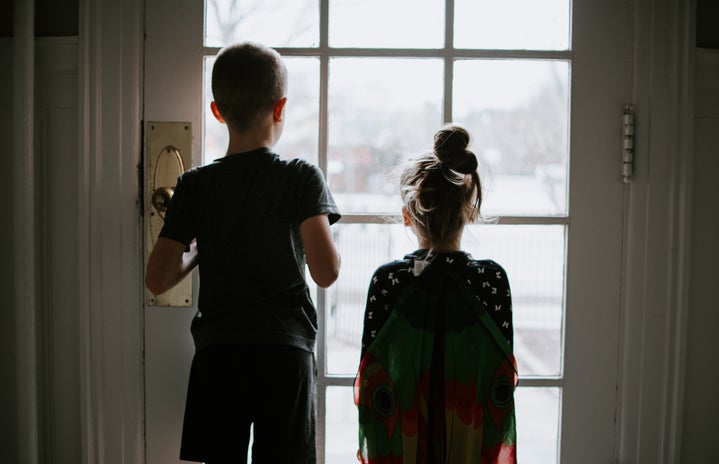Why has the children’s show gained so much popularity with adult audiences?
The world is a very noisy place. There are sounds coming from every corner and they are often loud and offensive, violent and hurtful, and the symphony of noise can become overwhelming. Normally, when I get overwhelmed by the world news, the pile of homework and the dread of life, I distract myself with some form of media, but even the TV shows and movies I watch tend to lean towards drama, murder investigations and societal fights.
Sometimes I need a breath from it all, so I’ll go outside and take a walk or read a positive book or write some poetry. Most recently, I have discovered a new outlet that includes consuming media, but with discretion and in a stress-free way. This discovery was the Disney kids TV show “Bluey.”
It started because I saw a Tweet of someone saying they love watching the show before going to sleep, and with all the audios from the series that went viral on TikTok, I was convinced to watch the first episode. Through giggles and a couple of shed tears, the first episode became the fourth, became the 10th, became the 30th. I now consider myself an avid “Bluey” viewer and a genuine fan of the show.
My afternoons of eating lunch between classes while enjoying the blue dog’s adventures with her family are amazing, but they also made me wonder why a kids’ TV show has gained so much popularity with adult, child-free audiences.
Sam Haysom explains in his Mashable article that the catch for him was the theme song. He starts off his review of the show with “My first memory of “Bluey” was that perfect theme song,” and I must agree. The theme song is short and sweet, it is quirky and shows off the main characters in a way that you can see a glimpse of their personality through their dancing.
I want to emphasize the “short and sweet” part because that is one of “Bluey’s” advantages: it keeps your attention. We live in a time of overstimulation and viral 15- to 60-second videos, we are the generation with the shortest attention spans and the most insatiable appetite for entertainment, and one thing that “Bluey” does right is catering to that. The episodes are eight minutes long and have simple story arcs that don’t need to connect with a bigger plot, so it is an easy watch if you want to take your mind off something for a little or if you want some background noise while eating.
“Bluey” has an easy way into virality and watchability because of its format, but its greatest strength lies in its content. Sophie Jacklin wrote for CBR about the 10 reasons why adults love Bluey, citing some reasons as teaching people about parenting, showing the wonders of domestic life and helping others heal from traumatic childhoods. The show is for kids, and it sticks to the light tone that it merits, but it doesn’t shy away from heavier topics such as grief, illness, friendship and love.
One episode that Kirsten Kalebich mentions in her article for Study Breaks is the episode where Bluey’s aunt visits, and her mom has to explain to Bluey that the aunt can’t have children, which is a burden many people have to live with. Similarly, there is also an episode where Bluey and her dad try to save a little bird they find hurt on the side of the road, and after the bird dies at the veterinary, she must learn about grief. These episodes keep a light tone and stay appropriate for children, but they also show the not-so-happy parts of life that we all must live with and how to deal with them both as a child and a parent.
Another factor people like about the show, according to Haysom, is its relatability. The parents, Chilli and Bandit, have a “weary-yet determined nature” that you often see in parents with young children. They play with Bluey and her sister, Bingo, and they listen to their made-up stories and games, but they also teach them valuable lessons and admit when they make mistakes.
This might also be why it is such a comfort show for many, because they may not have experienced positive home environments and find Bluey’s parents to be an image of what they missed out on.
From my perspective, “Bluey” also feeds on nostalgia. I love that the themes of the episodes always revolve around the games Bluey and Bingo play, and I love the seriousness and effort they put into the games because they remind me of myself as a child. When we grow up, we often forget about the joys of everyday life that we used to adore when we were children, we forget to jump on puddles, dance under the rain and enjoy the present. “Bluey,” like Jacklin mentions in her list, reminds us of the wonders we forgot about when we grew up and it teaches us that we can still have the same fun as adults; we just need to let go of our grumpiness and stop caring so much.
The show has been a success with children of all ages, but has also reached the hearts of adult audiences because of this new perspective into a peaceful domestic life. The daily adventures of the Australian family of dogs may seem simple and silly at first glance, but they have depth and show the viewers life lessons through joyful imagery and funny scenarios.
People love “Bluey” because the world already has enough complicated and convoluted media to consume. I can attest that there is a nice comfort in watching a show that doesn’t focus on drama or violence but instead on a family living a peaceful and loving life.


